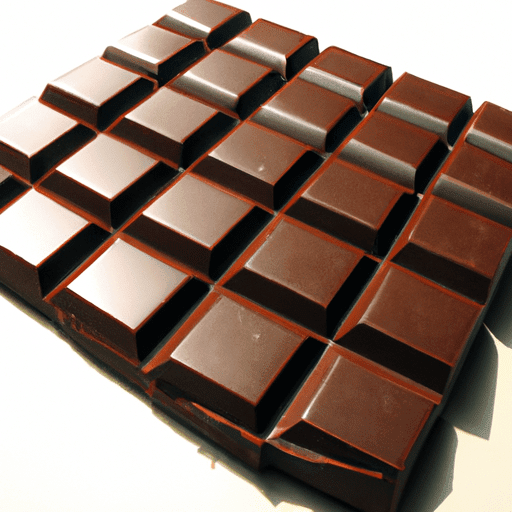The Delightful World of Milk Chocolate
When it comes to indulgent treats, milk chocolate reigns supreme. Its creamy and smooth texture combined with a delectable sweetness makes it a beloved favorite for people of all ages. In this blog post, we will take a deep dive into the world of milk chocolate, exploring its taste, common uses in cooking, nutritional value, and uncovering some interesting historical facts.
A Taste Sensation
Milk chocolate’s distinct and irresistibly sweet taste is what sets it apart from other varieties. With its signature velvety texture and notes of caramel, vanilla, and malt, it tantalizes the taste buds in every bite. The addition of milk powder or condensed milk creates a rich and creamy flavor that delivers a comforting sensation. Whether enjoyed on its own or used as an ingredient in recipes, milk chocolate never fails to satisfy even the most discerning chocolate lovers.
Versatility in the Kitchen
Milk chocolate’s versatility extends beyond its delectable taste - it also boasts an array of culinary applications. From baked goods to sauces, it can elevate any dish with its beautifully balanced sweetness.
In baking, milk chocolate chips or chunks add a luscious touch to cookies, muffins, and cakes. Imagine biting into a warm double chocolate chip cookie with gooey milk chocolate oozing out - pure bliss! And who can resist a moist chocolate cake layered with silky milk chocolate ganache?
Furthermore, milk chocolate can be melted down to create velvety drizzles over fruit and desserts, or transformed into a delectable sauce for ice cream and pancakes. With milk chocolate, the possibilities in the kitchen are truly endless.
Nutritional Benefits
While indulging in milk chocolate should still be enjoyed in moderation, it surprisingly offers some nutritional benefits. Milk chocolate contains essential minerals such as calcium, iron, magnesium, and potassium, which contribute to overall health. Additionally, it stimulates the release of endorphins, enhancing mood and providing a feeling of happiness and wellbeing.
However, it’s important to remember that milk chocolate also contains added sugar and fats, so managing portion sizes is crucial.
A Sweet History
Milk chocolate’s fascinating history dates back to the late 19th century when it was first invented by Swiss chocolatier Daniel Peter. His breakthrough came when he discovered a way to incorporate condensed milk into chocolate, resulting in the creation of the first milk chocolate bar.
Soon after, in 1904, the iconic Swiss company Nestlé collaborated with Peter to produce the world’s first commercially successful milk chocolate - the Nestlé Milk Chocolate Bar. This milestone marked the beginning of milk chocolate’s widespread popularity and the start of its beautiful journey into the hearts and mouths of chocolate enthusiasts worldwide.
Final Thoughts
Milk chocolate has undoubtedly left an indelible mark on the world of sweet treats. Its heavenly taste, versatility in cooking, and intriguing history make it a beloved choice for both bakers and chocolate connoisseurs alike. So, whether you’re enjoying a simple milk chocolate bar or incorporating it into your culinary creations, savor every bite and appreciate the sweetness that milk chocolate brings to our lives.
Interesting Facts about Milk Chocolate:
Origin: Milk chocolate is a type of chocolate that includes milk powder or condensed milk as one of its ingredients. It originated in Switzerland in the late 19th century, when Henri Nestlé invented condensed milk, and Daniel Peter combined it with chocolate.
Ingredients: Milk chocolate typically contains cocoa solids, milk solids (milk powder or condensed milk), sugar, and sometimes additional flavorings like vanilla. The amount of cocoa solids in milk chocolate can vary, but it generally contains a lower percentage of cocoa solids compared to dark chocolate.
Taste and Texture: The addition of milk solids in milk chocolate gives it a creamy and smooth texture. It has a milder, sweeter taste compared to dark chocolate due to the presence of milk and higher sugar content.
Common Uses: Milk chocolate is commonly used in confectionery and dessert making. It is popular in candy bars, truffles, chocolate-covered fruits, and as a coating for snacks such as pretzels and cookies. It can also be used in baking, adding a rich chocolate flavor to cakes, cookies, and brownies.
Nutritional Benefits: Milk chocolate is a source of several nutrients, including calcium, phosphorus, potassium, and vitamin D, due to the presence of milk solids. It also contains antioxidants called flavonoids, which are beneficial for heart health. However, it is important to note that milk chocolate is high in calories, sugar, and saturated fat, so it should be consumed in moderation as part of a balanced diet.
Properties: Milk chocolate has a lower melting point than dark chocolate due to the presence of milk solids, which gives it a softer texture. It may also have a lighter color compared to dark chocolate, ranging from light brown to a more creamy color.
Historical Significance: The invention and popularity of milk chocolate marked a significant milestone in the chocolate industry. The combination of chocolate and milk opened up new possibilities for creating sweeter and creamier chocolate flavors. This led to the development of various milk chocolate products and helped establish chocolate as a beloved treat worldwide.
Please note that while milk chocolate is enjoyed by many, it may not be suitable for individuals with lactose intolerance or dairy allergies.




Use the share button below if you liked it.
It makes me smile, when I see it.